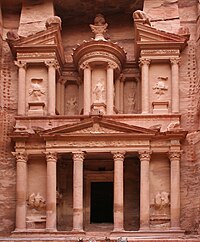| Petra (𐢛𐢚𐢓𐢈) | |||||||||||||
|---|---|---|---|---|---|---|---|---|---|---|---|---|---|
From top, left to right: the Urn Tombs, en-Nejr theatre, Al-Khazneh (Treasury), Qasr al-Bint temple and view of Ad Deir (Monastery) trail | |||||||||||||
| Location | Ma'an Governorate, Jordan | ||||||||||||
| Coordinates | 30°19′43″N 35°26′31″E / 30.32861°N 35.44194°E | ||||||||||||
| Area | 264 km2 (102 sq mi)[1] | ||||||||||||
| Elevation | 810 m (2,657 ft) | ||||||||||||
| Built | Possibly as early as the 5th century BC[2] | ||||||||||||
| Visitors | 1,135,300 (in 2019) | ||||||||||||
| Governing body | Petra Region Authority | ||||||||||||
| Website | www | ||||||||||||
| |||||||||||||
Petra (Arabic: ٱلْبَتْراء, romanized: Al-Batrāʾ; ‹See Tfd›Greek: Πέτρα, "Rock"), originally known to its inhabitants as Raqmu (Nabataean: 𐢛𐢚𐢒 or 𐢛𐢚𐢓𐢈, *Raqēmō),[3][4] is a historic and archaeological city in southern Jordan. Famous for its rock-cut architecture and water conduit systems, Petra is also called the "Rose City" because of the colour of the sandstone from which it is carved.[5] The city is one of the New 7 Wonders of the World and a UNESCO World Heritage Site.[6]
The area around Petra has been inhabited from as early as 7000 BC,[7] and was settled by the Nabataeans, a nomadic Arab people, in the 4th century BC. Petra would later become the capital city of the Nabataean Kingdom in the second century BC.[7][8] The Nabataeans invested in Petra's proximity to the incense trade routes by establishing it as a major regional trading hub, which gained them considerable revenue.[7][9] Unlike their enemies, the Nabataeans were accustomed to living in the barren deserts and thus were able to defend their kingdom. They were particularly skillful in agriculture, stone carving, and rainwater harvesting.
Petra flourished in the 1st century AD, when its Al-Khazneh structure, possibly the mausoleum of Nabataean king Aretas IV, was constructed, and its population peaked at an estimated 20,000 inhabitants.[10] Nabataea fell to the Romans in 106 AD, who annexed and renamed it as Arabia Petraea.[11] Petra's importance declined as sea trade routes emerged, and after an earthquake in 363 destroyed many structures. In the Byzantine era, several Christian churches were built, but the city continued to decline and, by the early Islamic era, it was abandoned except for a handful of nomads. It remained unknown to the western world until 1812, when Swiss traveller Johann Ludwig Burckhardt rediscovered it.[12]
UNESCO has described Petra as "one of the most precious cultural properties of man's cultural heritage".[13] Petra is a symbol of Jordan, as well as Jordan's most-visited tourist attraction. Visitor numbers reach close to a million tourists every year.[14]
- ^ "Management of Petra". Petra National Trust. Archived from the original on 19 April 2015. Retrieved 14 April 2015.
- ^ Browning, Iain (1973, 1982), Petra, Chatto & Windus, London, p. 15, ISBN 0-7011-2622-1
- ^ Stephan G. Schmid and Michel Mouton (2013). Men on the Rocks: The Formation of Nabataean Petra. Logos Verlag Berlin GmbH. ISBN 9783832533137. Archived from the original on 18 March 2020. Retrieved 14 November 2019.
- ^ Shaddel, Mehdy (2017-10-01). "Studia Onomastica Coranica: AL-Raqīm, Caput Nabataeae*". Journal of Semitic Studies. 62 (2): 303–318. doi:10.1093/jss/fgx022. ISSN 0022-4480. Retrieved 2020-12-08.
- ^ MAT, Mahmut (7 January 2023). "The Petra in Jordan » Geology Science". Geology Science.
- ^ ""The Lost City" of Petra Still Has Secrets to Reveal". Science. 2017-01-26. Archived from the original on October 10, 2019. Retrieved 2021-01-15.
- ^ a b c Cite error: The named reference
PNFwas invoked but never defined (see the help page). - ^ Mati Milstein. "Petra. The "Lost City" still has secrets to reveal: Thousands of years ago, the now-abandoned city of Petra was thriving". National Geographic. Archived from the original on 20 December 2019. Retrieved 27 December 2019.
- ^ Jack D. Elliott Jr. (1996). Joe D. Seger (ed.). The Nabatean Synthesis of Avraham Negev: A Critical Appraisal. Eisenbrauns. p. 56. ISBN 9781575060125. Archived from the original on 14 June 2020. Retrieved 27 December 2019.
{{cite book}}:|work=ignored (help) - ^ "Petra Lost and Found". National Geographic. 2 January 2016. Archived from the original on 8 April 2018. Retrieved 8 April 2018.
- ^ "Petra lost and found". History Magazine. 2018-02-09. Archived from the original on August 6, 2020. Retrieved 2021-01-15.
- ^ Glueck, Grace (17 October 2003). "ART REVIEW; Rose-Red City Carved From the Rock". The New York Times. Archived from the original on 28 December 2017. Retrieved 29 January 2018.
- ^ "UNESCO advisory body evaluation" (PDF). Archived (PDF) from the original on 2012-01-13. Retrieved 2011-12-05.
- ^ "Petra welcomed 905,000 visitors in 2022". The Jordan Times. 2 January 2023. Retrieved 3 January 2023.





